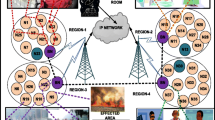Abstract
We are truly entering the era of Internet of Things (IoT) in which all things are connected and can be used in a variety of ways regardless of time and place. Various types of sensor devices using advanced technology will gather data around us and deliver the information wherever we want. In this paper, we propose an energy efficient MAC scheme for IoT ecosystem environments that include mobile IoT sensor devices. The mobile sensor devices in a target IoT ecosystem gather and collect any required data while moving and transmitting the collected data to a sink node. Energy consumption of the sensor devices depends on the distance from the sink node and also affects overall lifetime of the IoT ecosystems. The proposed 3-D group management MAC (3-D GM MAC) scheme groups sensor devices based on the distance (hop) from the sink node and transmits the collected data only to the next higher group level. That is, the data is transmitted only in the direction to the sink node. In addition, the energy efficiency of the entire IoT ecosystem can be improved by transmitting data based on pre-configured buffer threshold values that are set differently for each group and consequently minimizing the energy consumption of sensor devices near the sink node. When any sensor device cannot transmit data to the next higher group level due to movement, it is newly assigned an appropriate group number and transmits data using a new route. We have shown that the proposed 3-D GM MAC scheme shows excellent behavior in the aspect of energy efficiency for the target IoT ecosystem by simulation. Therefore, the proposed scheme might be adaptable for mobile sensor devices used in various kinds of computing and networking environments such as IoT, big data, cloud computing, and fog computing.













Similar content being viewed by others
References
El-Hoiydi A (2006) Aloha with preamble sampling for sporadic traffic in adhoc wireless sensor networks. IEEE ICC2006 5:3418–3423
El-Hoiydi A, Decotignie D, Enz C, LeRoux E (2003) Poser abstract; wise MAC, an ultra low power MAC protocol for the WiseNet wireless sensor network. ACM SenSys 03:685–692
Fafoutis X, Dragoni N (2011) ODMAC: an on-demand MAC protocol for energy harvesting—wireless sensor networks. In: ACM PE-WASUN ‘11, pp 49–56
Gupta GP, Misra M, Garg K (2015) An energy efficient distributed approach-based agent migration scheme for data aggregation in wireless sensor networks. J Inf Process Syst 11(1):148–164
Huang P, Xiao L, Soltani S, Mutka MW, Xi Huang N (2013) The evolution of MAC protocols in wireless sensor networks: a survey. IEEE Commun Surv Tutor 15(1):101–120
IEEE Std. 802.11-2008 (1999) IEEE standard for information technology—telecommunications and information exchange between systems—local and metropolitan area networks—specific requirements—Part 11: Wireless LAN medium access control (MAC) and physical layer (PHY) specifications. doi:10.1109/IEEESTD.2003.95617
IEEE Std. 802.11-2012 (2012) IEEE standard for information technology—telecommunications and information exchange between systems. Local and metropolitan area networks—Specific requirements. Part 11: Wireless LAN medium access control (MAC) and physical layer (PHY) specifications. doi:10.1109/IEEESTD.2012.6178212
Kim J-H, Choi S-J, Kim H-N (2005) Advanced MAC protocol with energy-efficiency for wireless sensor networks. In: ICOIN 2005, pp 687–699
Kim S, Joh H, Choi S, Ryoo I (2015) Energy efficient MAC scheme for wireless sensor networks with high-dimensional data aggregate. Hindawi Publ Corp Math Probl Eng 2015:1–13
Lu Z, Luo T, Wang X (2012) XY-MAC: a short preamble MAC with sharpened pauses for wireless sensor networks. In: Proceedings of the IEEE wireless communications and networking conference (WCNC’12), pp 1550–554
Nickray M, Afzali-Kusha A, Jäntti R (2015) Simultaneous power control and power management algorithm with sector-shaped topology for wireless sensor networks. EURASIP J Wirel Commun Netw 2015:118. doi:10.1186/s13638-015-0355-9
Singh B, Lobiya DK (2012) A novel energy-aware cluster head selection based on particle swarm optimization for wireless sensor networks. Hum Centric Comput Inf Sci 20122:13. doi:10.1186/2192-1962-2-13
Sohrabi K, Gao J, Ailawadhi V, Pottie GJ (2002) Protocol for self-organization of a wireless sensor network. IEEE Pers Commun 7(5):16–27
Sun K, Ryoo I (2015) A study on medium access control scheme for energy efficiency in wireless smart sensor networks. ICTC 2015
Tang L et al (2011) PW-MAC: an energy-efficient predictive-wakeup MAC protocol for wireless sensor networks. In: INFOCOM 2011. IEEE, pp 1305–1313. doi:10.1109/INFCOM.2011.5934913
van Dam T, Langendoen K (2003) An adaptive energy efficient MAC protocol for wireless sensor networks. In: ACM SenSys ’03, pp 171–180
Xu D, Wang K (2015) An adaptive traffic MAC protocol based on correlation of nodes. EURASIP. J Wirel Commun Netw 2015:258. doi:10.1186/s13638-015-0488-x
Ye W, Heidemann H, Estrin D (2002) An energy-efficient MAC protocol for wireless sensor networks. In: IEEE INFOCOM 2002, vol 3, pp 1567–1576
Yoo D-S, Choi SS (2010) Medium access control with dynamic frame length in wireless sensor networks. J Inf Process Syst 6(4):501–510
Yoon M, Kim Y-K, Chang J-W (2013) An energy-efficient routing protocol using message success rate in wireless sensor networks. J Converg 4(1):15–22
Acknowledgements
This research was supported by the MSIP(Ministry of Science, ICT and Future Planning), Korea, under the ITRC(Information Technology Research Center) support program (IITP-2016-R0992-16-1006) supervised by the IITP (Institute for Information & communications Technology Promotion), and this work was supported by the Soonchunhyang University Research Fund.
Author information
Authors and Affiliations
Corresponding author
Rights and permissions
About this article
Cite this article
Ryoo, I., Sun, K., Lee, J. et al. A 3-dimensional group management MAC scheme for mobile IoT devices in wireless sensor networks. J Ambient Intell Human Comput 9, 1223–1234 (2018). https://doi.org/10.1007/s12652-017-0557-6
Received:
Accepted:
Published:
Issue Date:
DOI: https://doi.org/10.1007/s12652-017-0557-6




